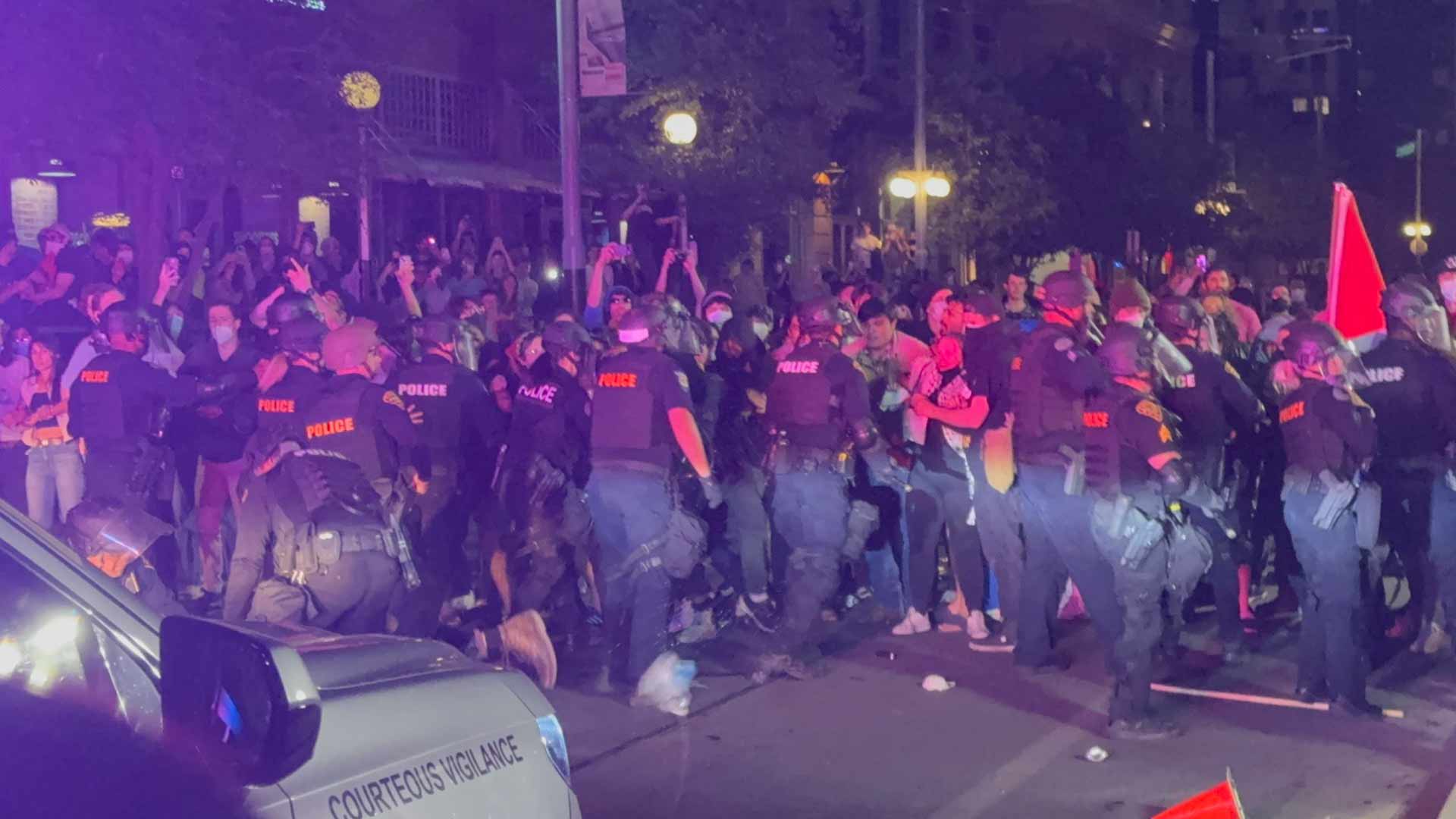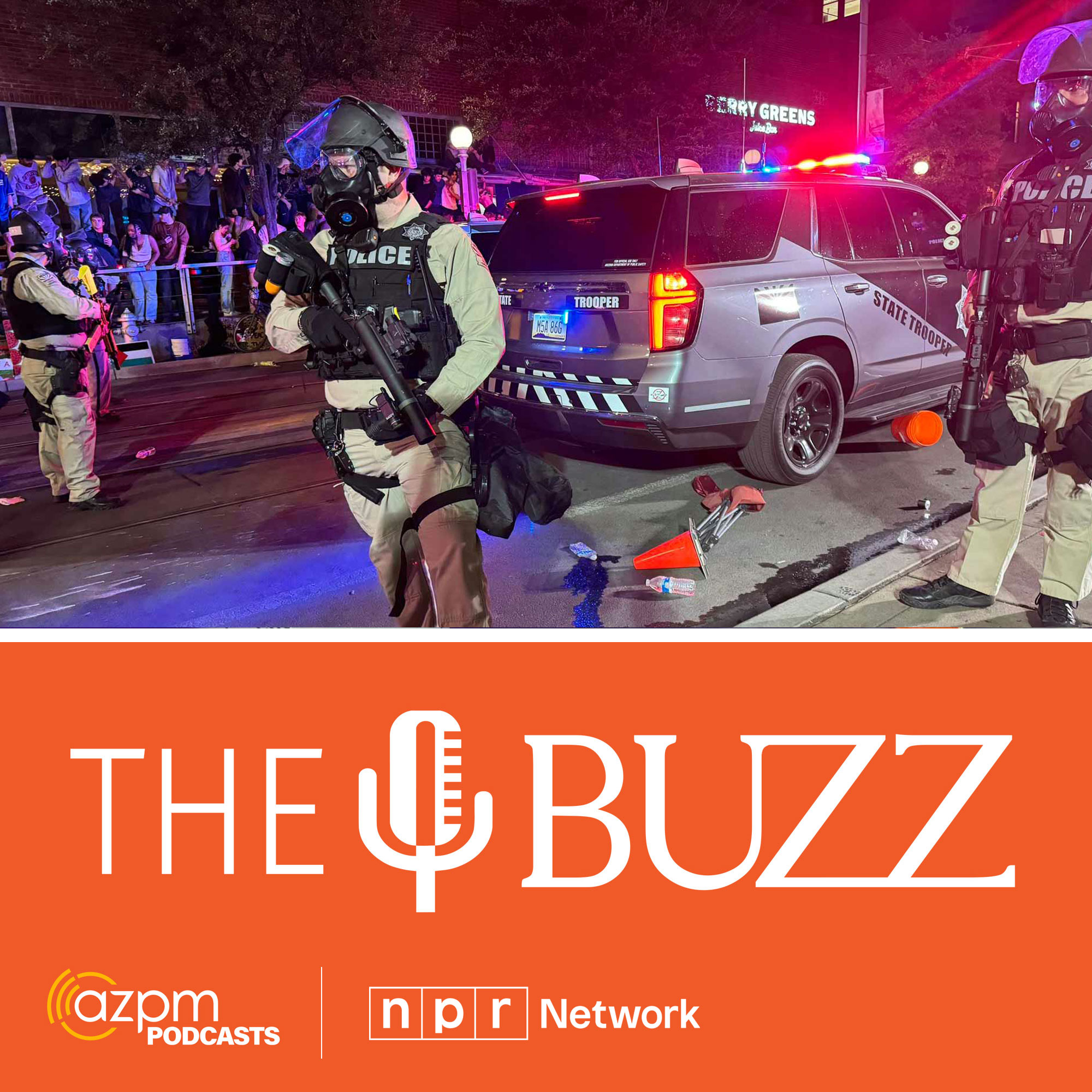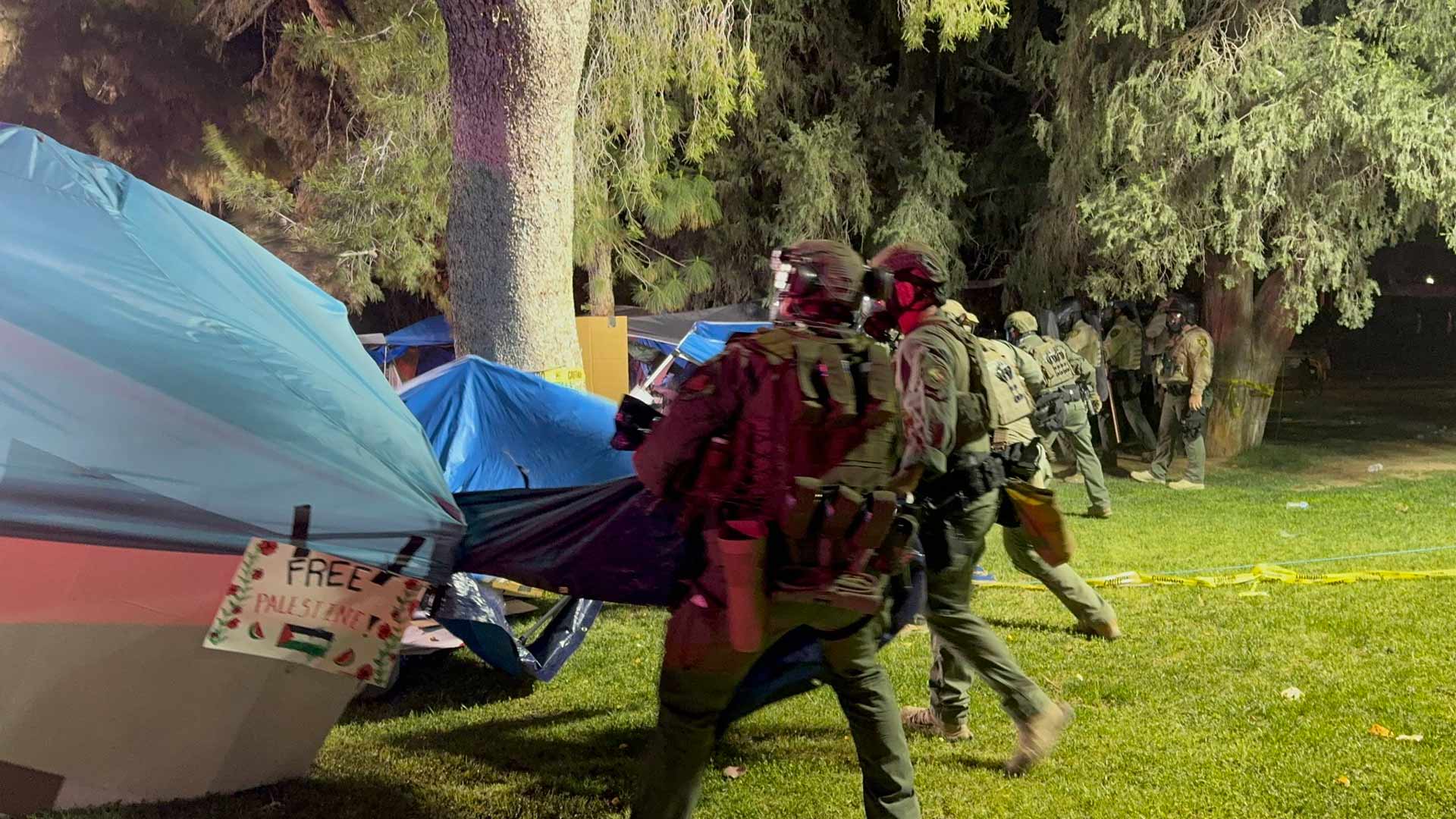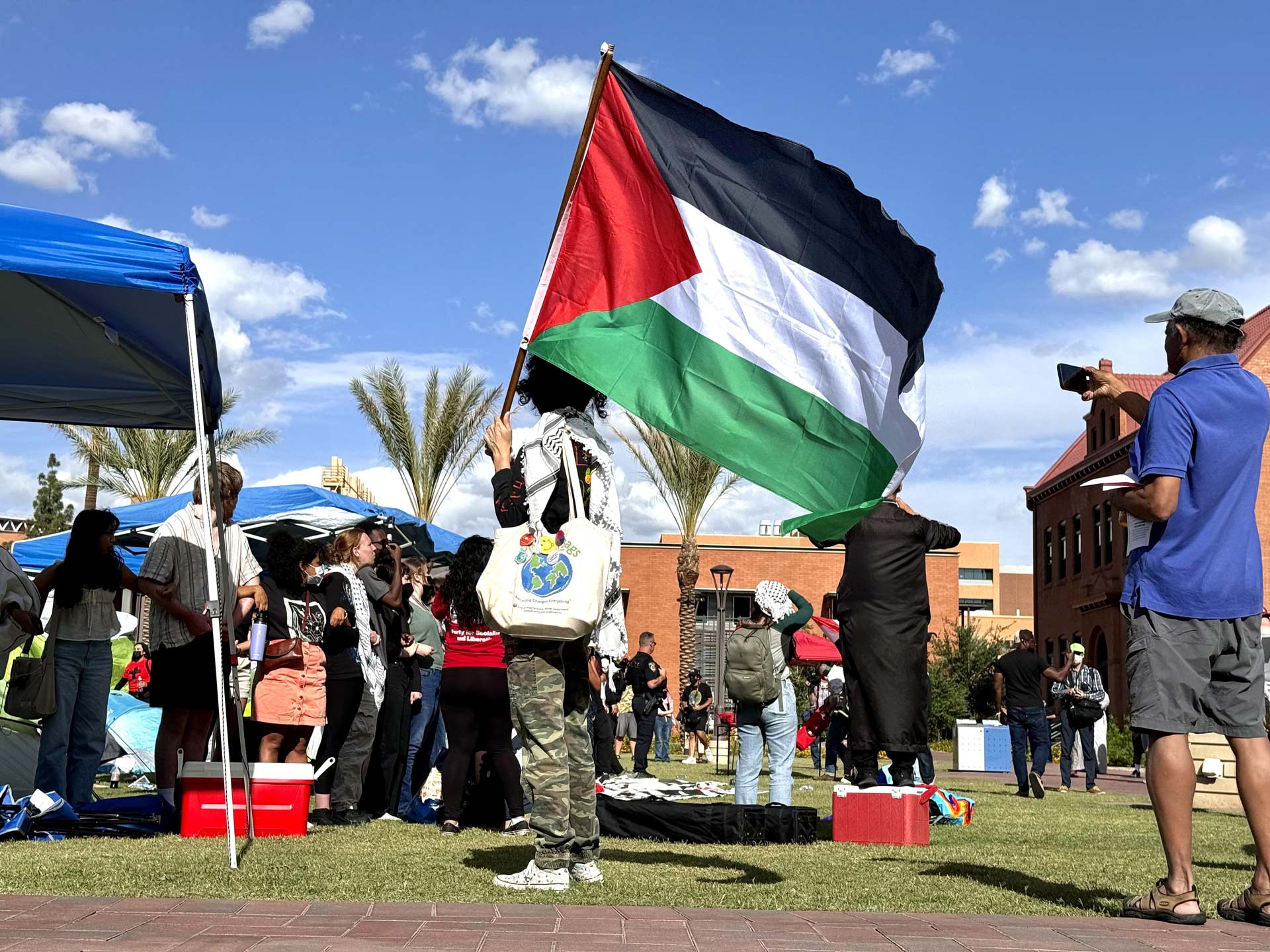 Police and protestors clash at 2:00 a.m. on Park Avenue on the edge of the University of Arizona campus as officers worked to break up a pro-Palestine encampment on campus. May 1, 2024
Police and protestors clash at 2:00 a.m. on Park Avenue on the edge of the University of Arizona campus as officers worked to break up a pro-Palestine encampment on campus. May 1, 2024
The Buzz for May 3, 2024

The week has ended quietly on Arizona's university campuses as students prepare for the end of the spring semester. That's a change from how things started, as groups of people ranging in size from hundreds to thousands gathered in protest.
The Associated Press reports that there have been about 2,300 arrests at protests against the Israel war in Gaza nationwide. Almost 100 of those have occurred on the campuses of Arizona's three state universities in the past week.
 VIEW LARGER The Buzz: Protests at Arizona's universities. The Buzz is available wherever you get your podcasts.
VIEW LARGER The Buzz: Protests at Arizona's universities. The Buzz is available wherever you get your podcasts.
Protests at the University of Arizona
In Tucson, those protests began on Monday, and reached their crescendo late Tuesday night into early Wednesday morning.
"On Monday, things were pretty much over before the 10:30 [P.M.] curfew that administration had given [protestors]," said AZPM reporter Hannah Cree, who has been covering the protests. "The group announced at 9:30, that they had held an internal vote, and not enough people voted in favor of staying and facing arrest that night. They cited the fact that a lot of participants on Monday were very young students, 18 or 19. And the lead organizer said it was detrimental to the cause if a bunch of people at their very first demonstration like this get arrested, it would actually prevent them from engaging in the future events like this."
She said the tone of the protest and accompanying encampment changed the next day as people reassembled in a different place, moving from the lawn in front of Old Main to a spot on the western edge of campus known as The Olive Grove. Protestors were again given a 10:30 curfew to disband the protest.
"Once we got to about 30 minutes past that curfew, administration approached the encampment one last time and told her protesters, 'Listen, the cops are really fired up, and they're ready to go. And are you sure that you really want to go through with this?' At that point, I understand the administration had made it clear that they were not ready to listen to your demands tonight. But we will listen tomorrow. And that did not make the protesters happy. "
By early Wednesday, law enforcement from the University of Arizona and Tucson police departments, Pima County Sheriff's deputies, and Arizona State Troopers had begun clearing the encampment and were attempting to move the crowd that numbered well into the hundreds off campus and north on Park Avenue, using less-lethal weapons, including pepper balls, tear gas, and rubber bullets.
"I talked to one protester who had been hit in the head with a rubber bullet and there was a pretty significant lump on his head," Cree said. "Police eventually pushed them back a block towards Speedway Boulevard and then when the dust cleared about half an hour later, we learned that four people were arrested in total, including two students, and charged with criminal trespassing."
 VIEW LARGER Law enforcement officers stormed a pro-Palestine encampment on the University of Arizona campus around 2:00 a.m. on May 1, 2024.
VIEW LARGER Law enforcement officers stormed a pro-Palestine encampment on the University of Arizona campus around 2:00 a.m. on May 1, 2024. Protests at Northern Arizona University
The numbers of protestors and arrestees were much greater at Northern Arizona University Tuesday night into Wednesday morning. The Arizona Daily Sun estimated that crowd at around 2,000 people, with law enforcement from a similar array of agencies arresting 24 people.
"Throughout [Tuesday], there were I think about 15 to 18 tents that had been set up and shade structures," said Daily Sun reporter Adrian Skabelund. "They set up a very informal barrier around the encampment. I was not able to be there the entire day, but there were some very limited counter-protesters. Some of the protesters had told me that they were approached by NAU administration several times throughout the day. Just as it was starting to get dark, NAU administration and NAU PD set up two large floodlights to illuminate the entire lawn."
Skabelund said that those assembled were more than just the encamped protestors from the NAU Chapter of Students for Justice in Palestine, though.
"There were a large number who may have been not affiliated with SJP, but had come out to support SJP or were chanting and holding signs. There were another group of people who essentially had come out to see what was going on. And then there was also a smaller group of folks who would have maybe been your kind of classic Coliseum goers. Folks who really, I don't know if they had strong opinions on whether they were pro or anti-Israel, but they were there to see what was going on, and see some heads get cracked or something like that."
One way that Skabelund noted a difference between UA and NAU protest break-ups was the use of less-lethal weapons to disperse the crowd.
"I didn't see any of those kinds of tactics. The main thing that police seem to essentially use was batons, I definitely didn't see any tear gas. Protesters and SJP has said that, at least in one case, they say that something like pepper spray might have been used, but there was no widespread use. It seems to be a more subdued response in terms of some of those immediate tactics used by police."
Protests at Arizona State University
 VIEW LARGER Protest supporting Palestinians at Arizona State University's Tempe campus on Friday, April 26, 2024.
VIEW LARGER Protest supporting Palestinians at Arizona State University's Tempe campus on Friday, April 26, 2024. The first place where protests began was at Arizona State University. Protests in Tempe started on Friday, April 26, with 69 arrests being made by early Saturday morning.
"I arrived around 4:30 [p.m.]. Police were present but no arrests were made," said Sophia Ramirez, managing editor of the ASU State Press student newspaper. "The protesters were linking arms in a chain around the encampment. There are people inside, lots of tents. They had food, medical supplies, masks like COVID protection masks, after the police presence kind of backed away around like six. We saw people chant and pray. And there was at one point a drum circle with a little kid dancing around."
Ramirez said authorities began making announcements at about 10:45 p.m. that crowds would need to disperse before 11:00.
"Arrests didn't start to be made until closer to midnight like 11:50. We estimated maybe 20 state trooper cars pulled up. At that point, we estimated like 350 protesters. And so when the State Troopers started to arrive, they made a large line from one end of Alumni Lawn to the other, backs against Old Main, and started pushing forward. They dragged tents away. They picked off pieces of the encampment including the food. And that's also when they started making arrests."
Ramirez said the crowd began dwindling quickly to about 200 at that point. She said tactics sounded similar to what happened at NAU and UA, though there was even less deployment of less-lethal weapons. The crowd of on-lookers was also notably smaller than at the other universities.
"There were definitely viewers at all times during the early evening. Later in the evening, when the arrests were made. I saw a handful of other viewers, people who especially lived in the area. We saw them walking in just to see what everything was about, especially when the police lights were to lit up. But I don't I did not see anywhere near 1000. I saw you know in the range of 15."
AZPM reached out to UA, NAU, ASU, and the Arizona Board of Regents seeking interviews for this episode. All declined our invitation, referring us instead to new statements or past ones issued on the matter.
The Arizona Board of Regents:
"The Board defends and upholds the First Amendment right to free expression. Individuals exercising these rights must nevertheless follow all applicable laws, university regulations, and the ABOR Code of Conduct. These rules and laws exist to protect teaching and learning on campus, uphold individuals’ right to free speech, and prioritize safety." The relevant portion of that code is policies 5-301 to 5-404
UA President Robert Robbins statement.
A statement from NAU Office of Communication and Media Relations
A statement from ASU Media Relations and Strategic Communications
The Arizona Board of Regents holds AZPM's broadcast licenses.




By submitting your comments, you hereby give AZPM the right to post your comments and potentially use them in any other form of media operated by this institution.